商务英语综合教程第3册第2单元参练习答案
- 格式:doc
- 大小:69.00 KB
- 文档页数:6
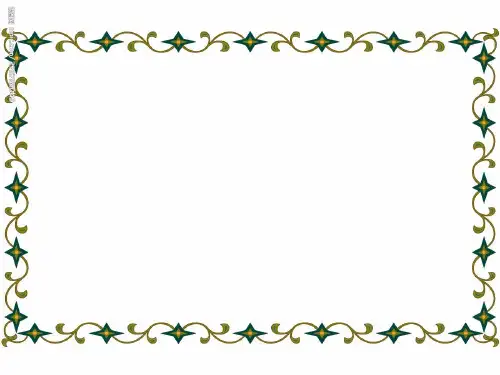
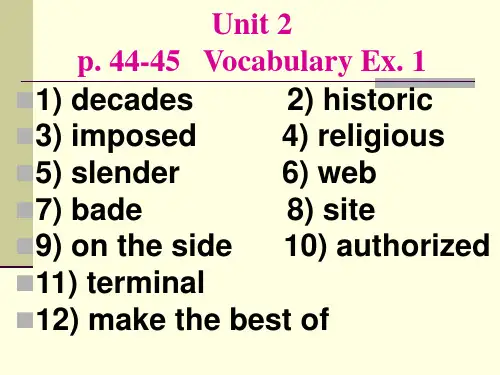

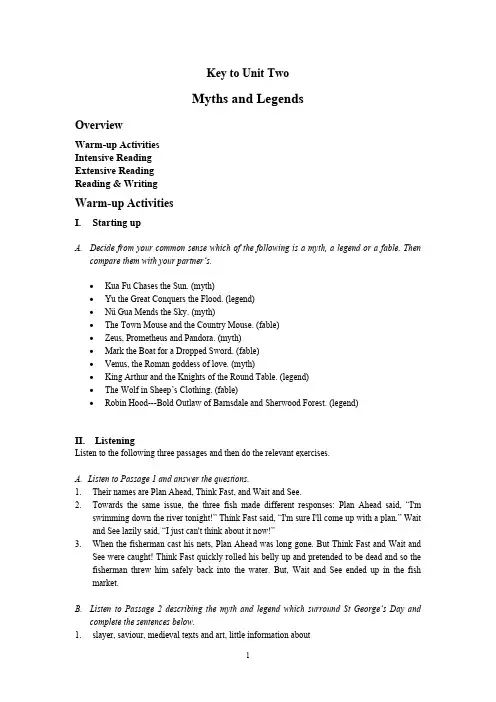
Key to Unit TwoMyths and LegendsOverviewWarm-up ActivitiesIntensive ReadingExtensive ReadingReading & WritingWarm-up ActivitiesI.Starting upA.Decide from your common sense which of the following is a myth, a legend or a fable. Thencompare them with your partner’s.∙Kua Fu Chases the Sun. (myth)∙Yu the Great Conquers the Flood. (legend)∙Nü Gua Mends the Sky. (myth)∙The Town Mouse and the Country Mouse. (fable)∙Zeus, Prometheus and Pandora. (myth)∙Mark the Boat for a Dropped Sword. (fable)∙Venus, the Roman goddess of love. (myth)∙King Arthur and the Knights of the Round Table. (legend)∙The Wolf in Sheep’s Clothing. (fable)∙Robin Hood---Bold Outlaw of Barnsdale and Sherwood Forest. (legend)II. ListeningListen to the following three passages and then do the relevant exercises.A.Listen to Passage 1 and answer the questions.1.Their names are Plan Ahead, Think Fast, and Wait and See.2.Towards the same issue, the three fish made different responses: Plan Ahead said, “I'mswimming down the river tonight!” Think Fast said, “I'm sure I'll come up with a plan.” Wait and See lazily said, “I just can't think about it now!”3.When the fisherman cast his nets, Plan Ahead was long gone. But Think Fast and Wait andSee were caught! Think Fast quickly rolled his belly up and pretended to be dead and so the fisherman threw him safely back into the water. But, Wait and See ended up in the fish market.B.Listen to Passage 2 describing the myth and legend which surround St George’s Day andcomplete the sentences below.1.slayer, saviour, medieval texts and art, little information about2.valorous deeds, 12th century, rescuing a king's daughter, slaying a dragon3.popularized, knights, Middle East4.have appeared, white robes, siege, patron saint, Henry V's victory5.stake a claim, invoke, exorcise demons, associated with fertilityC.Listen to Passage 3. In this part, you will hear a lecture given by a historian. He will talkabout the 1906 San Francisco earthquake myths which persist even after 100 years. After you have heard the lecture, select the best answer from the four given choices.1.B2.C3.D4.D5.C6.D7.A8.DIII. DiscussionB.Work in groups of three or four and discuss the following questions:1.Yes, it is. In the absence of scientific information of any kind, long ago societies all over theworld devised creation myths, resurrection myths, and complex systems of supernatural beings, each with specific powers, and stories about their actions. Since people were often isolated from each other, most myths evolved independently, but the various myths are surprisingly similar, in particular creation myths.2.The first function of myth is the need: myth is a universal need. Over time, one version of amyth would become the accepted standard that was passed down to succeeding generations, first through story-telling, and then, much later, set down in written form. Inevitably myths became part of systems of religion, and were integrated into rituals and ceremonies, which included music, dancing and magic.The second function of myth is to justify an existing social system and to account for its rites and customs. One constant rule of mythology is whatever happens among the gods reflects events on earth. In this way, events such as invasions and radical social changes became incorporated into myths. Some myths, especially those from the Greco-Roman and medieval periods, also serve to illustrate moral principles, frequently through feats of heroism performed by mortals.ExercisesI.Reading Comprehension1.Yes, they are. Myths are significant stories for their culture, and their significance sometimesresonates over millennia and far beyond their original culture. Myths permeate every culture, and are borrowed, retold, and live again in fresh imaginings. They are the stories of cultural beginnings, of how people's lives and ways of thinking came to be shaped, and they still help to shape the way that many people understand themselves and the world.2.Explanatory myths pose and offer the answers to questions that puzzle the philosophers. Suchquestions cannot be answered from a purely rational framework, and the greatest philosophers have sometimes resorted to the language of myth to treat such issues. On theother hand, etiological myths explain the range of phenomena in the world by offering answers that science casts aside, as science has its own rational explanations for celestial visitors like comets and eclipses, phenomena of the weather, geological formations, and the like, but these myths still offer a truth of the imagination, if not the scientific truth that can be weighed and calculated and predicted.3.Because m yths give the p eoples of the world reasons f or ritual, and enforce certain s ocialbehaviors with promises of divine favor and real t hreats of divine punishment.Especially in tribal cultures,myths are potent means of s ocializing children into the w ays of the people.Myths l ay down the many important rules, for instance, for t he right behavior towarda nimals that are hunted, or s et up the precedent for a people's system of law.4.This is due to the cultural differences. In times before literacy was widespread, in the daysbefore the printing press, myths were told and retold countless times. Some cultures valued the precise words of their myths as sacred texts given to them by the gods, and they sought to transmit their myths in exactly the same way. Other cultures enjoyed varying the elements of the story, so that each time the myth was retold, it would be slightly different, with its listeners enjoying the variations as part of the pleasure of hearing this particular version of the traditional tale.5.Besides using words as a medium to pass on m yths from generation to generation, peoplealso use sacred artworks or carvings on rocks, special dances or music, and ritual enactment to spread myths.6.Perhaps it is because all peoples have a thirst for insights into the mysteries of life, from theorigin of consciousness to the end of the world. And myths tend to have an enduring power because they do not limit the world to statistically verifiable facts and figures, because they people the familiar world with wonder and marvel, and because they intersect humanity with the world of the animals and that of the gods. All myths stretch our ways of perceiving the world, and have the power to lift us away from our mental habits.7.He says that we need the stories of myth to make sense of the confusion of our society andour own psyches. Myths voice the truths of our unconscious selves, and the gods, goddesses, and heroes of myth embody aspects of creativity, cleverness, grief, joy, aggression, and ecstasy.The monsters of myth are really monsters of the mind; the tragedies and triumphs of myth reflect upon the ways in which we seem to be tossed to and fro psychologically by forces that are beyond our control. Human beings are myth-makers by nature, always curious, always psychologically living out the patterns of myth or being lived out by them.8.Because the printing press came into popular use, and it has helped to fix one form of astory as the correct version. Besides, radio, film, television, and video have also helped to fix more stories, which in turn discouraged the art of telling and retelling traditional stories over and over again.9.The Internet. Myth may once again flourish in chat rooms and e-mail transmissions, ona scale far beyond that of the ancients.10.Because in our life some popular figures are loved by people and sometimes they are eventreated as people’s idols all over the world. When they died, people will use different ways to commemorate them and gradually the stories told about them will have different variations and become more or less myths.II.Paraphrase1.For their own cultures, myths are important stories which are liked, enjoyed by the peopleand they have lasted for thousands of years, and what is more, they even spread through all the other foreign cultures, and gain new versions, interpretations and variations while being told. (Para. 2)2.Some myths explain the hard questions and describe the difficult phenomena which thephilosophers want to understand.(Para. 3)3.Many myths focusing on the causes and reasons of the natural phenomena have their ownunderstandings and interpretations towards these things. But science does not think they are right because it has its own reasonable explanations for the space issues, for instance, the comets, the eclipses, the change of the weather, the geological formations and so on. But in these myths there is a certain truth although the truth cannot be regarded as the scientific one, as the latter can be measured and seen in advance. (Para. 4)4.Myths give the people of all nationalities in the world the reasons for religious ceremonies,emphasize and strengthen the social manners. If they follow the practice, they can get the praise and honour from a god or God, otherwise, they will be likely punished by them. (Para.5)5.Most myth writers are unknown because they were told long before the writing came intobeing, and only few of the first story tellers could be known. (Para. 6)6.Myths are told in different forms. We can find them in the religious paintings, rock carvings,unique dances or music, and religious performance. (Para. 7)7.Certainly some myths give praise and thanks to a state or city, give religious punishment toinvasion and political control over other countries, but this is not the reason why these myths could last much longer than the state or the empire themselves for several thousand years.The reason is that in the myths there is something which is strong and super enough which makes the myths go far beyond the reason itself and the different cultures. (Para. 8)8.Myths are likely to last longer because they do not restrict themselves to the confirmed factsand numbers, because they give wonders and surprises to people in their normal life, and because they join the world of animals and the world of gods with the world of human beings.(Para. 9)9.By nature human beings love to create myths because they want to know about things, and inheart they want to experience the life style in myths or they wish the life style of myths could be part of their experience. (Para. 11)10.The sudden, large increase of great sadness people felt over the death of Princess Diana is thesame as people all over the world felt over the much earlier and unexpected death of the Norse god Baldr. (Para. 13)III. Word Practice1.strenuous2.afresh3.variation4.permeated5.embody6.transcend7.glorify8.precedentmemorate 13.console14.outlast15.ecstasyExtended ActivitiesII.Word Practice1.calculated2.transmitted3.decoration4.to enforce5.insights6.posed7.claimed8.distorted9.determined10.stumbled11.predicted12.advent13.celebrates14.Perceiving15.fascinatingIII.Cloze1.head2.invaders3.persuaded4.battle5.stake6.glimpse7.period8.chaos9.surrounding10.grasp11.fascinated12.victory13.conclude14.symbol15.bombardingIV. Translation1.The lives of many different scientists have shaped the way that people view the world.2.Chinese scientists have traced the severe acute respiratory syndrome (SARS) virus back to asimilar virus found in the civet cat, an animal found in the wild in China.3.If the fantasy originates at the moment of loss, then it must gesture toward a mythic origin.4.Located in the heart of Kabul, Flower Street is different at Christmas from any other time ofthe year, transformed into a festival place.5.You may have failed the examination, but you can at least console yourself with the thoughtthat you did your best.Extensive ReadingChinese Creation MythologyExercisesI.Speed Reading Comprehension1.B2.C3.C4.A5.DIII.Word Practice1.merging2. trailing3.weird4. purports5.cardinal6.transformed7. whirl8.wander9. propriety 10.trodden Reading & WritingJupiter’s Love Towards EuropaExercisesI. Reading Comprehension1.C2.C3.A4.B5.D。



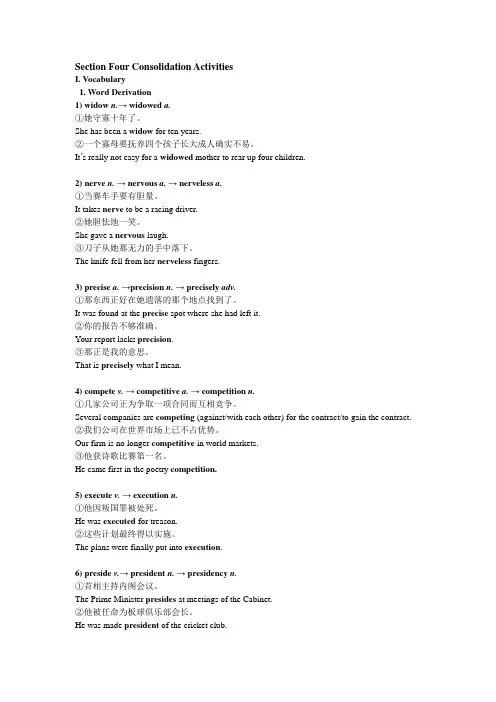
Section Four Consolidation ActivitiesI. Vocabulary1. Word Derivation1) widow n.→ widowed a.①她守寡十年了。
She has been a widow for ten years.②一个寡母要抚养四个孩子长大成人确实不易。
It’s really not easy for a widowed mother to rear up four children.2)nerve n.→ nervous a.→ nerveless a.①当赛车手要有胆量。
It takes nerve to be a racing driver.②她胆怯地一笑。
She gave a nervous laugh.③刀子从她那无力的手中落下。
The knife fell from her nerveless fingers.3)precise a.→precision n. → precisely adv.①那东西正好在她遗落的那个地点找到了。
It was found at the precise spot where she had left it.②你的报告不够准确。
Y our report lacks precision.③那正是我的意思。
That is precisely what I mean.4)compete v.→ competitive a.→ competition n.①几家公司正为争取一项合同而互相竞争。
Several companies are competing (against/with each other) for the contract/to gain the contract.②我们公司在世界市场上已不占优势。
Our firm is no longer competitive in world markets.③他获诗歌比赛第一名。


商务英语3-ComprehensiveExercisesf答案商务英语3-Comprehensive Exercise答案请认真阅读一下说明然后下载:学校每学期有可能都要更换题库!请仔细核对是不是您需要的题目再下载第1题– but what do you want me to do there?– ______________________________A. You have to give a presentation on what our products are.B. Thank you so much for doing such a favor for me.C. Take it easy. There’s nothing to be worried about.正确答案是:You have to give a presentation on what our products are.第2题–– we are headquartered in shanghai.A. How about the departmental structure in the headquarters?B. What is your company profile?C. Where are your headquarters?正确答案是:Where are your headquarters?第3题– _______________– i think our marketing team is qualified and the after-sales service is fast and effective.A. What does your team do?B. What are the disadvantages?C. What about our strengths?正确答案是:What about our strengths?第4题– good morning. far east logistics company. .–good morning. this is maggie bonner. i would like to know more about your freight forwarding business.A. Who is that calling?B. What do you want?C. What can I do for you?正确答案是:What can I do for you?第5题–– for individual income tax, it is within the first 7 days.A. What is the deadline for tax declaration?B. What do you mean by taxable services?。
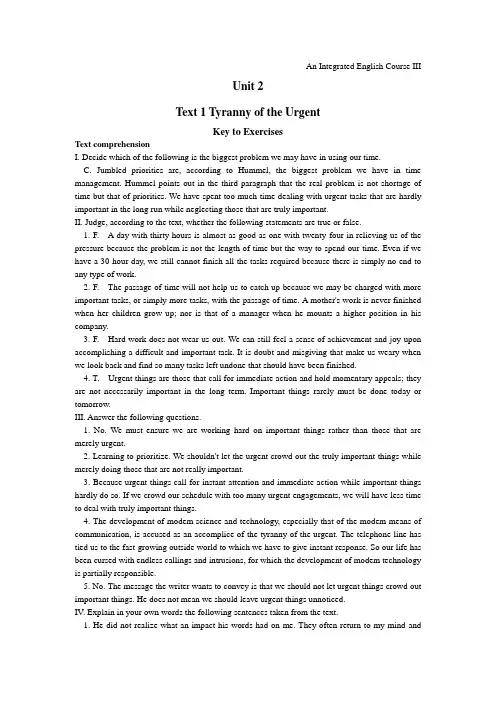
An Integrated English Course IIIUnit 2Text 1 Tyranny of the UrgentKey to ExercisesText comprehensionI. Decide which of the following is the biggest problem we may have in using our time.C. Jumbled priorities are, according to Hummel, the biggest problem we have in time management. Hummel points out in the third paragraph that the real problem is not shortage of time but that of priorities. We have spent too much time dealing with urgent tasks that are hardly important in the long run while neglecting those that are truly important.II. Judge, according to the text, whether the following statements are true or false.1. F. A day with thirty hours is almost as good as one with twenty-four in relieving us of the pressure because the problem is not the length of time but the way to spend our time. Even if we have a 30-hour day, we still cannot finish all the tasks required because there is simply no end to any type of work.2. F. The passage of time will not help us to catch up because we may be charged with more important tasks, or simply more tasks, with the passage of time. A mother's work is never finished when her children grow up; nor is that of a manager when he mounts a higher position in his company.3. F. Hard work does not wear us out. We can still feel a sense of achievement and joy upon accomplishing a difficult and important task. It is doubt and misgiving that make us weary when we look back and find so many tasks left undone that should have been finished.4. T. Urgent things are those that call for immediate action and hold momentary appeals; they are not necessarily important in the long term. Important things rarely must be done today or tomorrow.III. Answer the following questions.1. No. We must ensure we are working hard on important things rather than those that are merely urgent.2. Learning to prioritize. We shouldn't let the urgent crowd out the truly important things while merely doing those that are not really important.3. Because urgent things call for instant attention and immediate action while important things hardly do so. If we crowd our schedule with too many urgent engagements, we will have less time to deal with truly important things.4. The development of modem science and technology, especially that of the modem means of communication, is accused as an accomplice of the tyranny of the urgent. The telephone line has tied us to the fast-growing outside world to which we have to give instant response. So our life has been cursed with endless callings and intrusions, for which the development of modem technology is partially responsible.5. No. The message the writer wants to convey is that we should not let urgent things crowd out important things. He does not mean we should leave urgent things unnoticed.IV. Explain in your own words the following sentences taken from the text.1. He did not realize what an impact his words had on me. They often return to my mind andreproach me with the grave problem of priorities.2. But from a long-term perspective, they no longer seem to be important as they promised, and we suffer from a sense of loss when we recall those important tasks left undone.Structural analysis of the textThe writer supports his argument by using a number of facts and examples in addition to reasoning.Rhetorical features of the textSo we find ourselves working more and enjoying it less (Paragraph 2 ); "we have left undone those things, which we ought to have done; and we have done those things which we ought not to have done" ( Paragraph 3).Vocabulary exercisesI. Explain the underlined part in each sentence in your own words.1. a series of; a number of (tasks) that come one after the other2. demanding more care, effort and attention3. weighed on my mind; affected me4. earnest call for instant attention5. in view of6. been dominated byII. Fill in the blank in each sentence with a word taken from the box in the proper form.1. prominent 2:. rebuked 3. breach 4. priority5. haunt6. tyranny7. imperious8. misgivingIII. Fill in the blank in each sentence with an appropriate phrasal verb or collocation taken from the text.1. crowded out2. catch up3. calls/called for4. involved in5. pushing aside6. wish forIV. Fill in the blanks' with the appropriate forms of the given words.1. tyrants2. urgency3. relieved4. undoubtedly5. irresistibly6. deceiveV. Explain the underlined phrasal verbs in your own words.1. affects2. catching up with 3, been involved in4. doing5. tell6. rejectedGrammar exercisesI. Note how the coordinated structures are joined together in the following sentences.Pay attention to the connectors and punctuation marks used in the coordinated structures.Note that the connectors and, but, or and nor are frequently followed by shortened sentences. II. Complete the following sentences using proper coordinators.1. not only ... but also2. Either or3. and4. or5. so6. and7. neither ... nor8. butIII. Combine the following sentences into a paragraph, using coordinators. Make other changes if necessary.The recorded history of mankind is only 6,000 or 7,000 years, but within that short period of time many civilizations have risen and fallen. The people of the Nile Valley created a high culture, and so did the people of the Tigris-Euphrates Valley, but both of these cultures disappeared. They were absorbed into the Greco-Roman culture that dominated the Mediterranean world, but this civilization also disintegrated in time.IV. Punctuate the following sentences, using commas or stops. Make some changes if necessary.1. The butterfly is a marvel. It begins as an ugly caterpillar and turns into a work of art.2. The earthquake was devastating, Tall buildings crumbled and fell to the earth.3. The child hid behind his mother, for he was afraid of the dog.4. We have to help the children. Or, more precisely, we have to help them to help themselves.5. Both John and I had many errands to do: yesterday. John had to go to the post office and bookstore. I had to go to the drugstore, the travel agency and the bank.6. He's walking in the garden, the dog is playing at his feet, and the children are following him. V. Make sentences of your own after tile sentences given below, keeping the underlined parts in your sentences.1. He considers Jane's opinion as valuable as any of ours.Waves of red light are about twice as long as waves of blue light.2. He taught himself to play the violin by practicing all night.I did not think she would do any good by coming over.Translation exercisesI. Translate the following sentences into English, using the words given in the brackets.1. Memories of his childhood haunted him.2. More volunteers are needed to finish the exacting work.3. Housing ranks first on my list of priorities.4. Father rebuked his son for being lazy.5. In his The Way to Wealth, Franklin gave readers many maxims on how to achieve earthly success.6. His imperious manner was more than I could bear.7. The fire devoured the forests.8. The newspaper won't accept any deceptive advertisements.II. Translate the following passage into Chinese.我们经常面临一大堆尚未完成的任务,因此我们希望一天有30个小时。
全新版大学英语综合教程3Unit2答案全新版大学英语综合教程3Unit2答案全新版大学英语综合教程3共8个单元。
下面是店铺分享的.全新版大学英语综合教程3第二单元Unit2的答案,欢迎大家阅读!全新版大学英语综合教程3Unit2答案UNIT 2VocabularyI.1.1) decades 5) slender 9) on the side2) historic 6) web 10) authorized3) imposed 7) bade 11) terminal4) religious 8) site 12) make the best of2.1) went through 2) stood up for 3) laid down 4) take on5) let (us) down 6) draw on 7) fall into 8) pass for3.1) The Europeans are fully confident that the Americans will not be able to justify their measures to protect the struggling American steel industry.2) Clinton is, in the eyes of Joe Klein, staff writer of the New Yorker and author of The Natural, the most talented politician of his generation and the most compelling.3) There's not much you can do if people are really intent on destroying themselves with drugs.4) A different experience of the world could forge a completely different approach to life.5) It is our conviction that cloning of human beings is bound to cause many ethical and social problems in the long run.4.1) As for, do not compel, capture of, have forged2) At huge risk, the mission, shelter3) who abolished, In the eyes of, racialII. Words with Multiple Meanings1. I'll tell you in a minute how I have attained the genuine sense of belonging in America, but first let me hear about your French trip.2. Most McDonald's look almost the same on the outside, but actually there are about 16 differ?ent basic designs.3. Loaning money from the banks is but one of the methods we can use to get through a financial crisis.4. This second-hand car has been nothing but trouble; it's always breaking down.5. In your resume you've mentioned everything but one vital point.6. Our technicians have discovered a simple but effective solution to the problem.7. I am sorry, but I think you shouldn't have lingered on over coffee and missed the last bus..8. The bankruptcy of the company was not caused by evil, but by simple ignoranceIII. Usage1) lonely 2)friendly 3) weekly, monthly 4)lovely5) cowardly 6)kindly/ saintly 7) lively 8)motherlyComprehensive ExercisesI. Cloze1. Text-related1)forged 2) stand up 3) compelled 4)convictions 5)mission6)abolish 7) intent on 8) risk 9)in the eyes of 10)threats2. (Theme-related)1) assistance 2) involved 3) estimated 4)coincidence5)emerged6) referred 7) numerous 8) stationed 9)concern 10)captureII. Translation1. Though greatly affected by the consequences of the global financial crisis, we are still confident that we can face up to the challenge and overcome the crisis.2. Under threat of constant sand storms, we were compelled to leave our cherished village and move to the new settlement.3. According to a recent online survey, a lot of consumers say they may be motivated to consider buying products shown in TV commercials.4. Having spotted a truck driver dumping contaminated waste alongside the river, the old man reported to the police at once.5. Some scientists hold to the firm conviction that people will come to like genetically modified crops someday since they can increase yields and help combat hunger and disease in the developing world.Shortly after he achieved freedom Henson became intent on assisting fugitive slaves. He secretly returned to the United States from Canada several times to help others to travel the Underground Railroad to freedom. Once some slave catchers closed in on the escaping slaves and Henson when they were on the run. He disguised them and successfully avoided capture. Later he built a small settlement in Dresden in Canada for escaped slaves, setting up a chapel and a school. He held to the conviction that slavery would be abolished, and the day was bound to come when racialdiscrimination no longer existed.全新版大学英语综合教程3Unit2答案21 Inside viewConversation 1-1Conversation 1-2C D A F B B EConversation 1-3A AB B B AConversation 2-1B B B D D AConversation 2-21)2) a typical suburb3) the age of cight/the age of 84) more protective5) your schooldays6)7) 16/sixteen8) That's tascinating9) I have no ideaget my researchBConversation 2-3B B B2-2 Outside viewDWatching and understanding 1A E C1)Watching and understanding 2where there is war/ where there's wargo to schoolworking in 157 countries/working in one hundred and fifty-seven countrics4) has never known peace5) bringing medicinc0刀8 get an educationforty thousand kids / 40000 kids / 40.000 kidsgirls were not allowed9) 50 per cent / 50%/50 percent/ fifty percent /fifty percent10) running the school for 12 years/ running the school fortwelve yearsWatching and understanding 3E F C A B D AWatching and understanding 4D A B B A2-3 Listening inNews reports 1A CNews reportsPassage 1-11. husband2. church3. favorite aunt and uncle4. farm5. 26. 147. 20CPassage 1-2B ACD APassage 2-1A B A B B B APassage 2-21. looking forward2. apart from3. on4. fight a lot5. angel6. supportive7. cash/money2-4 Presentation skillsPractice 1Reference:1. Your parents: Parents are protective and concerned about safcty.Your grandparents: Parents were less led about safety, and more confident about societv.Lfu2. Your parent: Often everybody cats separately because they are busy.Your grandparents: Everybody ate together.3. Your parents: Spend time together with young children but not with older children.Your grandparents: Spent time together because there wasn't much other entertainment.4. Your parents: Both parents cook and do housework. Your grandparents: Women were expected to cook and do housework more than men.5. Your parents: Good relationship except for a few times when we were teenagers.Your grandparents: Good relationship nearly all the time.6. Your parents: Spend more time indoors.Your grandparents: Children spent plenty of time outdoors.7. Your parents: Less strict but not easygoing: moreunderstanding.Your grandparents: Cienerally strict.8. Your parents: Watch as much as possible but don't have much time.Your grandparents: No TV: they listened to the radio.9. Your parents: Parents sacrific rongly support us to succeed.Your grandparents: Parents were keen but there were not so many opportunities.2-5 Pronunciation2-6 Unit testUnit 2短对话5题1) She wasn't prepared for the cost every month.2) The journalist looks like a mouse.3) It is far from the road.4) It is impossible to understand a culture if you don't speak the language.5) They want to listen to music.长对话3题6) B. They are irresponsible.7)A. He is willful and gets into trouble.8) C. Bccause he is at work all day.短文理解3题9) B. To present someone with an award.10) C. It's impossible.11) D. Mr. Larson tcaches young children.短篇新闻3题12) A. Two Syrians were sentenced to jail over thedrowning of five people.13)B. Three years old.14)C. On a beach in southwest Turkey.。
新标准商务英语综合教程3参考答案Unit2知乎1、-We’ve spent too much money recently–well,it isn’t surprising. Our friend and relatives_______around all the time [单选题] *ingB. had comeC. were comingD have been coming(正确答案)2、A survey of the opinions of students()that they admit several hours of sitting in front of the computer harmful to health. [单选题] *A. show;areB. shows ;is(正确答案)C.show;isD.shows ;are3、24.I often ask my English teacher some questions ________ e-mail. [单选题] *A.by(正确答案)B.inC.forD.with4、It took a long time to _______ Tom to go shopping with me. [单选题] *A. speakB. tellC. persuade(正确答案)D. talk5、The more he tried to please her, _____she seemed to appreciate it. [单选题] *A.lessB.lesserC.the less(正确答案)D.the lesser6、What do you think of the idea that _____ honest man who married and brought up a large family did more service than he who continued single and only talked of _____ population. [单选题] *A. a, /B. an, /C. a, theD. an, the(正确答案)7、She often _______ at 21: [单选题] *A. go to bedB. gets upC. goes to bed(正确答案)D. gets to8、—What’s the matter with that boy?—______.()[单选题] *A. He is watching TV in his roomB. He takes his temperatureC. He was playing a toy carD. He hurt his right leg(正确答案)9、Boys and girls, _______ up your hands if you want to take part in the summer camp(夏令营).[单选题] *A. puttingB. to putC. put(正确答案)D. puts10、It is my _______ to meet you here. [单选题] *A. pleasure(正确答案)B. pleaseC. pleasedD. pleasant11、He couldn’t ______ the maths problem without your help. [单选题] *A. work out(正确答案)B. work atC. work forD. work with12、Ladies and gentlemen, please fasten your seat belts. The plane _______. [单选题] *A. takes offB. is taking off(正确答案)C. has taken offD. took off13、Jim is a(n) _______. He is very careful and likes to work with numbers. [单选题] *A. secretaryB. tour guideC. accountant(正确答案)D. English teacher14、The blue shirt looks _______ better on you than the red one. [单选题] *A. quiteB. moreC. much(正确答案)D. most15、This girl is my best friend, Wang Hui. ______ English name is Jane.()[单选题] *A. HeB. HisC. SheD. Her(正确答案)16、Mom is making dinner. It _______ so nice! [单选题] *A. smells(正确答案)B. tastesC. feelsD. sounds17、—______ do you play basketball?—Twice a week.()[单选题] *A. How often(正确答案)B. How muchC. How manyD. How long18、14.He is cutting the apple ________ a knife. [单选题] * A.inB.toC.with(正确答案)D.by19、It _____ us a lot of time to do this job. [单选题] *A. spentB. madeC. took(正确答案)D. cost20、Will you be able to finish your homework _______? [单选题] *A. by the timeB. in time(正确答案)C. once upon a timeD. out of time21、You have been sitting on my hat and now it is badly out of(). [单选题] *A. dateB. shape(正确答案)C. orderD. balance22、The scenery is so beautiful. Let’s _______. [单选题] *A. take photos(正确答案)B. take mapsC. take busD. take exams23、Mum, this T-shirt is much too small for me. Would you buy me a _______ one? [单选题] *A. niceB. largeC. nicerD. larger(正确答案)24、_______ travelers come to visit our city every year. [单选题] *A. Hundred ofB. Hundreds of(正确答案)C. Five HundredsD. Five hundred?of25、The teacher asked him to practice playing the piano _______. [单选题] *A. often as possibleB. as often possibleC. as possible oftenD. as often as possible(正确答案)26、Our campus is _____ big that we need a bike to make it. [单选题] *A. veryB. so(正确答案)C. suchD. much27、Jim wants to hang out with his friends at night, but his parents don’t allow him ______ so. ()[单选题] *B. doneC. to do(正确答案)D. doing28、—______some nice crayons. I think they are ______.()[单选题] *A. Here is; Betty’sB. Here are; BettyC. Here is; BettyD. Here are; Betty’s(正确答案)29、—______ my surprise, Zhu Hui won the first prize in the speech contest. —But I think he could, because he kept practicing speaking.()[单选题] *A. To(正确答案)B. AboutC. ForD. In30、Sitting at the back of the room()a very shy girl with two bright eyes. [单选题] *A. is(正确答案)B. areD. there was。
一、选择填空,从A、B、C三个选项中选出一种能填入空白处旳最佳选项。
(每题10分)题目1对旳获得10.00分中旳10.00分题干——We are headquartered in Shanghai.选择一项:A. How about the departmental structure in the headquarters?B. What is your company profile?C. Where are your headquarters?反馈对旳答案是:Where are your headquarters?题目2对旳获得10.00分中旳10.00分题干—Kathy,I'd like you to meet Maggie Jacobs.— , Maggie. You're doing a great job.选择一项:A. I'm pleased to meet youB. It's great to see you againC. I'm happy to meet you too反馈对旳答案是:I'm pleased to meet you题目3对旳获得10.00分中旳10.00分题干Sometimes a situation will a direct style of management. 选择一项:A. call upB. call forC. call on反馈对旳答案是:call for题目4对旳获得10.00分中旳10.00分题干Sometimes a situation will_______a direct style of management.选择一项:A. call upB. call forC. call on反馈对旳答案是:call for题目5对旳获得10.00分中旳10.00分They ______ over at great length the matter of how to increase the sale of your products last night.选择一项:A. talkB. have talkedC. talked反馈对旳答案是:talked二、阅读理解(每题10分)题目6部分对旳获得50.00分中旳40.00分题干阅读下面旳文章,根据文章内容判断文章后旳句子是对旳(T)还是错误(F)。
Unit 2 The Company ManKey to the ExercisesText comprehensionI. Decide which of the following best states the author’s tone of writing。
BII. Judge,according to the text,whether the following statements are true or false.1。
T (Refer to Paragraph 1.)2。
T (Refer to Paragraph 3.)3。
F (Refer to Paragraph 4. To Phil, a golf game was work.)4. F (Refer to Paragraphs 7 and 8。
She had been missing (lost)him all these years, and she must have given up part of herself which had cared too much for the man。
)5。
F (Refer to Paragraph 15.)III。
Answer the following questions。
1。
Refer to Paragraphs 1, 3 and 15。
By repeating that Phil worked himself to death at precisely 3:00 a。
m. Sunday morning,the author highlights the peculiarity of the time which proves the tragic nature of his death.2。
Refer to Paragraph 9。
In the day and a half before the funeral,Phil’s eldest son went around the neighborhood to ask the neighbors what his father was like, which embarrassed his neighbors. The fact reveals the relationship between Phil and his son and that between Phil and his neighbors。
Key to Unit TwoMyths and LegendsOverviewWarm-up ActivitiesIntensive ReadingExtensive ReadingReading & WritingWarm-up ActivitiesI. Starting upA.Decide from your common sense which of the following is a myth, a legend or a fable. Thencompare them with your partner’s.•Kua Fu Chases the Sun. (myth)•Yu the Great Conquers the Flood. (legend)•Nü Gua Mends the Sky. (myth)•The Town Mouse and the Country Mouse. (fable)•Zeus, Prometheus and Pandora. (myth)•Mark the Boat for a Dropped Sword. (fable)•Venus, the Roman goddess of love. (myth)•King Arthur and the Knights of the Round Table. (legend)•The Wolf in Sheep’s Clothing. (fable)•Robin Hood---Bold Outlaw of Barnsdale and Sherwood Forest. (legend)II. ListeningListen to the following three passages and then do the relevant exercises.A. Listen to Passage 1 and answer the questions.1. Their names are Plan Ahead, Think Fast, and Wait and See.2. Towards the same issue, the three fish made different responses: Plan Ahead said, “I'mswimming down the ri ver tonight!” Think Fast said, “I'm sure I'll come up with a plan.” Wait and See lazily said, “I just can't think about it now!”3. When the fisherman cast his nets, Plan Ahead was long gone. But Think Fast and Wait andSee were caught! Think Fast quickly rolled his belly up and pretended to be dead and so the fisherman threw him safely back into the water. But, Wait and See ended up in the fish market.B.Listen to Passage 2 describing the myth and legend which surround St George’s Day andcomplete the sentences below.1.slayer, saviour, medieval texts and art, little information about2.valorous deeds, 12th century, rescuing a king's daughter, slaying a dragon3.popularized, knights, Middle East4.have appeared, white robes, siege, patron saint, Henry V's victory5.stake a claim, invoke, exorcise demons, associated with fertilityC.Listen to Passage 3. In this part, you will hear a lecture given by a historian. He will talkabout the 1906 San Francisco earthquake myths which persist even after 100 years. After you have heard the lecture, select the best answer from the four given choices.1. B2. C3. D4. D5. C6. D7. A8. DIII. DiscussionB. Work in groups of three or four and discuss the following questions:1.Yes, it is. In the absence of scientific information of any kind, long ago societies all over theworld devised creation myths, resurrection myths, and complex systems of supernatural beings, each with specific powers, and stories about their actions. Since people were often isolated from each other, most myths evolved independently, but the various myths are surprisingly similar, in particular creation myths.2.The first function of myth is the need: myth is a universal need. Over time, one version of amyth would become the accepted standard that was passed down to succeeding generations, first through story-telling, and then, much later, set down in written form. Inevitably myths became part of systems of religion, and were integrated into rituals and ceremonies, which included music, dancing and magic.The second function of myth is to justify an existing social system and to account for its rites and customs. One constant rule of mythology is whatever happens among the gods reflects events on earth. In this way, events such as invasions and radical social changes became incorporated into myths. Some myths, especially those from the Greco-Roman and medieval periods, also serve to illustrate moral principles, frequently through feats of heroism performed by mortals.ExercisesI. Reading Comprehension1. Yes, they are. Myths are significant stories for their culture, and their significance sometimesresonates over millennia and far beyond their original culture. Myths permeate every culture, and are borrowed, retold, and live again in fresh imaginings. They are the stories of cultural beginnings, of how people's lives and ways of thinking came to be shaped, and they still help to shape the way that many people understand themselves and the world.2. Explanatory myths pose and offer the answers to questions that puzzle the philosophers. Suchquestions cannot be answered from a purely rational framework, and the greatest philosophers have sometimes resorted to the language of myth to treat such issues. On theother hand, etiological myths explain the range of phenomena in the world by offering answers that science casts aside, as science has its own rational explanations for celestial visitors like comets and eclipses, phenomena of the weather, geological formations, and the like, but these myths still offer a truth of the imagination, if not the scientific truth that can be weighed and calculated and predicted.3. Because m yths give the p eoples of the world reasons f or ritual, and enforce certain s ocialbehaviors with promises of divine favor and real t hreats of divine punishment.Especially in tribal cultures,myths are potent means of s ocializing children into the w ays of the people.Myths l ay down the many important rules, for instance, for t he right behavior towarda nimals that are hunted, or s et up the precedent for a people's system of law.4. This is due to the cultural differences. In times before literacy was widespread, in the daysbefore the printing press, myths were told and retold countless times. Some cultures valued the precise words of their myths as sacred texts given to them by the gods, and they sought to transmit their myths in exactly the same way. Other cultures enjoyed varying the elements of the story, so that each time the myth was retold, it would be slightly different, with its listeners enjoying the variations as part of the pleasure of hearing this particular version of the traditional tale.5. Besides using words as a medium to pass on m yths from generation to generation, peoplealso use sacred artworks or carvings on rocks, special dances or music, and ritual enactment to spread myths.6. Perhaps it is because all peoples have a thirst for insights into the mysteries of life, from theorigin of consciousness to the end of the world. And myths tend to have an enduring power because they do not limit the world to statistically verifiable facts and figures, because they people the familiar world with wonder and marvel, and because they intersect humanity with the world of the animals and that of the gods. All myths stretch our ways of perceiving the world, and have the power to lift us away from our mental habits.7. He says that we need the stories of myth to make sense of the confusion of our society andour own psyches. Myths voice the truths of our unconscious selves, and the gods, goddesses, and heroes of myth embody aspects of creativity, cleverness, grief, joy, aggression, and ecstasy.The monsters of myth are really monsters of the mind; the tragedies and triumphs of myth reflect upon the ways in which we seem to be tossed to and fro psychologically by forces that are beyond our control. Human beings are myth-makers by nature, always curious, always psychologically living out the patterns of myth or being lived out by them.8. Because the printing press came into popular use, and it has helped to fix one form of astory as the correct version. Besides, radio, film, television, and video have also helped to fix more stories, which in turn discouraged the art of telling and retelling traditional stories over and over again.9. The Internet. Myth may once again flourish in chat rooms and e-mail transmissions, ona scale far beyond that of the ancients.10. Because in our life some popular figures are loved by people and sometimes they are eventreated as people’s idols all over the world. When they died, people will use different ways to commemorate them and gradually the stories told about them will have different variations and become more or less myths.II. Paraphrase1. For their own cultures, myths are important stories which are liked, enjoyed by the peopleand they have lasted for thousands of years, and what is more, they even spread through all the other foreign cultures, and gain new versions, interpretations and variations while being told. (Para. 2)2. Some myths explain the hard questions and describe the difficult phenomena which thephilosophers want to understand.(Para. 3)3. Many myths focusing on the causes and reasons of the natural phenomena have their ownunderstandings and interpretations towards these things. But science does not think they are right because it has its own reasonable explanations for the space issues, for instance, the comets, the eclipses, the change of the weather, the geological formations and so on. But in these myths there is a certain truth although the truth cannot be regarded as the scientific one, as the latter can be measured and seen in advance. (Para. 4)4. Myths give the people of all nationalities in the world the reasons for religious ceremonies,emphasize and strengthen the social manners. If they follow the practice, they can get the praise and honour from a god or God, otherwise, they will be likely punished by them. (Para.5)5. Most myth writers are unknown because they were told long before the writing came intobeing, and only few of the first story tellers could be known. (Para. 6)6. Myths are told in different forms. We can find them in the religious paintings, rock carvings,unique dances or music, and religious performance. (Para. 7)7. Certainly some myths give praise and thanks to a state or city, give religious punishment toinvasion and political control over other countries, but this is not the reason why these myths could last much longer than the state or the empire themselves for several thousand years.The reason is that in the myths there is something which is strong and super enough which makes the myths go far beyond the reason itself and the different cultures. (Para. 8)8. Myths are likely to last longer because they do not restrict themselves to the confirmed factsand numbers, because they give wonders and surprises to people in their normal life, and because they join the world of animals and the world of gods with the world of human beings.(Para. 9)9. By nature human beings love to create myths because they want to know about things, and inheart they want to experience the life style in myths or they wish the life style of myths could be part of their experience. (Para. 11)10. The sudden, large increase of great sadness people felt over the death of Princess Diana is thesame as people all over the world felt over the much earlier and unexpected death of the Norse god Baldr. (Para. 13)III. Word Practice1. strenuous2. afresh3. variation4. permeated5. embody6. transcend7. glorify8. precedent9. anonymous10. legitimate 11. cast 12. commemorate 13. console 14. outlast 15. ecstasyExtended ActivitiesII. Word Practice1. calculated2. transmitted3. decoration4. to enforce5. insights6. posed7. claimed8. distorted9. determined 10. stumbled 11. predicted 12. advent13. celebrates 14. Perceiving 15. fascinatingIII. Cloze1. head2. invaders3. persuaded4. battle5. stake6. glimpse7. period8. chaos9. surrounding 10. grasp 11. fascinated 12. victory13. conclude 14. symbol 15. bombardingIV. T ranslation1. The lives of many different scientists have shaped the way that people view the world.2. Chinese scientists have traced the severe acute respiratory syndrome (SARS) virus back to asimilar virus found in the civet cat, an animal found in the wild in China.3. If the fantasy originates at the moment of loss, then it must gesture toward a mythic origin.4. Located in the heart of Kabul, Flower Street is different at Christmas from any other time ofthe year, transformed into a festival place.5. You may have failed the examination, but you can at least console yourself with the thoughtthat you did your best.Extensive ReadingChinese Creation MythologyExercisesI. Speed Reading Comprehension1. B2. C3. C4. A5. DIII. Word Practice1. merging2. trailing3. weird4. purports5. cardinal6. transformed7. whirl8. wander9. propriety 10. trodden Reading & WritingJupiter’s Love Towards EuropaExercisesI. Reading Comprehension1. C2. C3. A4. B5. D。